Visit: 2nd/3rd January 2015
By Tom
The Megalithic Temples of Malta WHS consists of six sites dotted around the country of Malta’s two main islands: the islands of Malta and Gozo. From the Greek for ‘great stones’, these megalithic structures are some of the oldest in the world, all of them pre-dating Stonehenge.
Natalie and I went to Malta for New Year’s Eve and for the first few days of 2015. We stayed in an apartment in Valletta (also a WHS in its own right), using it as a base to explore the island. Unfortunately we weren’t able to visit all six of the Temples, but we managed four – which will do for now. Malta actually has three WHS in total – the third is the Hypogeum, which is an underground temple. The Hypogeum, however, is known to be one of the most restrictive WHS in the world in terms of numbers of visitors it lets in. Only 80 visitors per day are allowed into the site, and places are booked up weeks in advance. Since I planned this Malta trip at the last minute there was no way we were getting into the Hypogeum, so I’ll be saving that for a future visit, along with the two temples we didn’t see.
So what did we see? First off, we walked out through the sprawling urban area that flows out from Valletta and includes most of the country’s population. We were heading for Tarxien temples – a site which is very close to the Hypogeum and is nowadays in the middle of a built-up area, which somewhat detracts from the pre-historic atmosphere.
We were struck by the number of Africans loitering about the streets in the dockside areas, presumably looking for work. The EU has a migration problem that it seems unable to address, and one of the highest profile manifestations of that is the regularity with which ships full of prospective migrants are reported to be sinking off the coast of Italy. Malta is situated in between Sicily and Lampedusa – the Italian island which saw a ship sink off its coast in 2013 with the loss of 366 lives – and has presumably taken in more than its fair share of migrants fleeing desperate situations. Whether they are legally recognised or their present is simply overlooked by the authorities I do not know.
At Tarxien the structure consists of three separate, but attached, temples. Founded some time between 3250 & 2800 BC, they are thought to have been used for animal sacrifice and cremation of the dead. There is a raised walkway that takes you around the site, then the trail takes you into the temples themselves. It is thought they used to be roofed, but today they are open-air.
The next day I rented a car and – after a slow start thanks to the hire company’s incompetence – we drove to the north of the island until we reached Mosta, where there are two temples within a kilometre of one another. One of the pleasant aspects of Malta is the frequency with which you come across magnificent church buildings – in Mosta their local church just happens to have the third largest unsupported dome in the world, according to Wikipedia.
Just a few metres from this church is a temple of a different era – the Megaliths of Ta’ Ħaġrat. The temple dates from 3600-3200 BC, and its distinctive feature is the striking doorway shown in the photograph at the top of this page.
Not far away lies the least visually impressive of the temples we saw. However, do not let its ruined state deceive you – this is made up for by the fact that the Skorba temple is almost 7000 years old, dating from 4850-3600 BC! To put this in perspective, Stonehenge is a sprightly 5000 years old (archaeologists have dated construction to 3000-2000 BC).
Following Skorba we continued to drive north, all the way to the tip of the island of Malta, at Ċirkewwa harbour. After enjoying some impressive views along the way, we drove our car onto a roll-on, roll-off ferry for the 30 minute voyage to Gozo.
The island of Gozo is rich in history and culture of its own. We didn’t have much time there, so limited ourselves to visiting the single Megalithic temple there and going to see the ‘Azure Window’, of Game of Thrones fame.
Ġgantija temple is the largest and most visually impressive of the four temples we saw. Similar in magnitude to Stonehenge – though less refined – it was founded around 3600 BC. When it was originally inscribed in 1980, the WHS covered only this temple. The other five were added in a 1992 extension of the inscription.
The temple contains two main apses, and you can walk around inside them. In the pictures above and below you can clearly see the circular holes that have been drilled through the megaliths, perhaps to allow a beam to be fitted for some kind of door. Since the temples on Malta were constructed prior to the Bronze Age the builders would have had no metal tools, and apparently the wheel had not yet been introduced to the island either! This lack of technology only highlights what an achievement it was to have built a temple that rises to as much as six metres in height.
The temple stayed in use for about a thousand years, before being abruptly and mysteriously abandoned in the third millennium BC. Eventually Bronze Age people re-adopted it as a cremation site. The name of the site comes from the Maltese word ġgant, meaning ‘giant’. This is because before the British arrived in the early 19th century the locals believe it was the remains of a defensive tower built by a race of giants in the distant past.
Finally, we headed over to the western end of the island for a non-WHS sight – the Azure Window. Featured in Game of Thrones as the location of a first series wedding scene, it is a limestone arch that struts out over the sea.
I found it remarkably similar to Durdle Door – part of the WHS-inscribed Jurassic Coast – which I visited in December 2013 with Ross (although the weather in Malta was a little calmer, as you can see!).

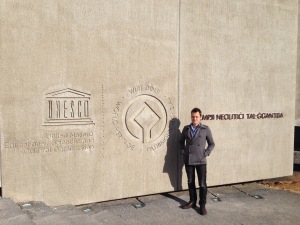
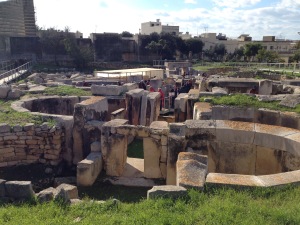


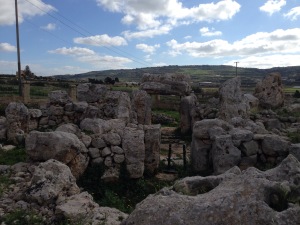


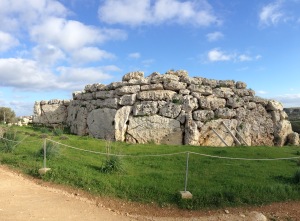



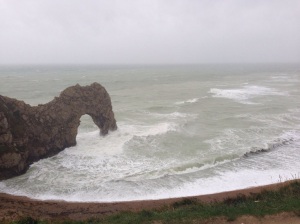
Pingback: • City of Valletta | Tom's and Ross's World Heritage Site travel blog
Pingback: • Historic Monuments of Ancient Kyoto (Kyoto, Uji and Otsu Cities) | Tom's World Heritage Site travel blog
Reblogged this on Die Goldene Landschaft.